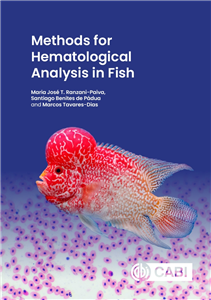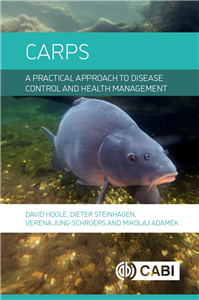Your Search Results
-
Promoted Content
-
Promoted ContentAquaculture & fish-farming: practice & techniquesFebruary 2021
Breeding and Culture of Freshwater Ornamental Fish
by Archana Sinha & Pramod Kumar Pandey
The Book Breeding and Culture of Freshwater Ornamental Fish deals with recent scenario and technology of freshwater ornamental fish. The book contains 15 chapters including FAQ and suggested readings. The book covers in depth subjects such as status, breeding techniques, food and health management and marketing of freshwater ornamental fishes. There is a separate chapter on breeding of indigenous freshwater ornamental fishes. Emphasis is given on national and international legislation related to ornamental fish export and import. The book contains a useful chapter on the importance and role of ornamental plants and accessories. Aquarium making and decoration is well explained for a hobbyist. Water quality management and maintenance of aquarium have been dealt in great detail by the author as those are the important components of aquarium keeping. Packaging and transport of these fishes are dealt with proper explanation with view to promote proper trade of the ornamental fishes. Author has highlighted the behaviour and biology of important fishes and tried to link these aspects with captive management practices. FAQ and Suggested readings addvalues to the book, as they address many curiosities of the readers. The way chapters are presented in the book, it makes it quite interesng and relevant to the present scenario. Photographs are very aracve.Students, sciensts, academicians, hobbyists and entrepreneurs will certainly enjoy and would be greatly bene?ted and enriched by reading this interesng and well wrien book as it addresses the concerns of each of them.
-
 Trusted Partner
November 2025
Trusted Partner
November 2025Methods for Hematological Analysis in Fish
by Maria José Ranzani Paiva, Santiago Benites de Pádua, Marcos Tavares-Dias
Hematology is a vital tool for monitoring the health of and diagnosing disease in both humans and veterinary species. With the growth of aquaculture across the globe, it has also become increasingly necessary to understand and maintain fish health. Fish hematology thus has a significant potential to contribute to better fish farming practice through the application of clinical research. This book comprehensively covers all aspects of fish hematology and describes the best techniques for blood sample collection and the analysis and interpretation of blood count. The morphological description of the blood cells of different species of fish is presented in a comparative manner with rich illustrations, and the book also includes a detailed discussion of the cytochemical methods applied in blood cell studies. Additionally, the book: Provides high-quality information about fish hematology in a well-organized and comprehensive manner. Gives a detailed description of best-practice techniques, from sample collection to handling and analysis. Addresses a knowledge gap in the guidance and scientific training of new veterinary professionals. Written for all levels of academic ability, this book is an essential resource for anyone working within fish hematology and, with interest in the topic growing, it presents the first complete picture of the subject.
-
 Trusted Partner
Lifestyle, Sport & LeisureDecember 2024
Trusted Partner
Lifestyle, Sport & LeisureDecember 2024The Handbook of Ornamental Fish Health and Welfare
by Nick Saint-Erne, Nick Saint-Erne
This book forms a complete resource covering ornamental fish health and welfare from a recognized expert on the topic. Beginning with an overview of the tropical fish industry and aquarium keeping, it covers all the key elements of care, including water-quality testing and maintenance, filtration systems, nutrition, husbandry, handling and transportation of fish, disease diagnosis, treatments and medications, and disease prevention. It also reviews areas of wider interest, such as biosecurity and zoonoses. The book can be read through to gain a complete overview of the care and welfare of ornamental aquarium and pond fish, or it can be used to easily look up specific information about a topic of interest. With numerous illustrations and photographs, plus references allowing readers to study areas of interest in more detail, this book makes an invaluable teaching and reference handbook. It is a vital source of information for veterinarians, scientists using fish in their labs, students, ornamental fish breeders, retail pet store workers, and aquarium keepers looking for trusted advice about how to properly care for their ornamental freshwater fish.
-
 Trusted Partner
Technology, Engineering & AgricultureAugust 2020
Trusted Partner
Technology, Engineering & AgricultureAugust 2020Climate Change and Infectious Fish Diseases
by Patrick T K Woo, Jo-Ann Leong, Kurt Buchmann
This definitive reference work explores the effects of current and expected climate change, taking place throughout the world, on selected bacterial, viral, fungal and parasitic infectious fish diseases of economically important fish in tropical and temperate waters.
-
 Trusted Partner
Technology, Engineering & AgricultureApril 2017
Trusted Partner
Technology, Engineering & AgricultureApril 2017Fish Viruses and Bacteria
Pathobiology and Protection
by Patrick T K Woo, Rocco C Cipriano
Taking a disease-based approach, Fish Viruses and Bacteria: Pathobiology and Protection focuses on the pathobiology of and protective strategies against the most common, major microbial pathogens of economically important marine and freshwater fish. The book covers well-studied, notifiable piscine viruses and bacteria, including new and emerging diseases which can become huge threats to local fish populations in new geographical regions if transported there via infected fish or eggs. A concise but thorough reference work, this book: - Covers key viral and bacterial diseases of notable fish species; - Reviews major well-established piscine pathogens as well as new, emerging and notifiable diseases; and - Contains the most up-to-date research contributed by a team of over fifty world experts. An invaluable bench book for fish health consultants, veterinarians and all those wanting instant access to information, this book is also a useful textbook for students specializing in fish health and research scientists initiating fish disease research programmes. ; Taking a disease-based approach, this book focuses on the pathobiology of and protective strategies against the most common, major microbial pathogens of economically important marine and freshwater fish. It covers well-studied, notifiable piscine viruses and bacteria, including new and emerging diseases. ; 1: Infectious Pancreatic Necrosis Virus, Arun K. Dhar, Scott LaPatra, Andrew Orry and F.C. Thomas Allnutt 2: Infectious Haematopoietic Necrosis Virus, Jo-Ann C. Leong and Gael Kurath 3: Viral Haemorrhagic Septicaemia Virus, John S. Lumsden 4: Epizootic Haematopoietic Necrosis and European Catfish Virus, Paul Hick, Ellen Ariel and Richard Whittington 5: Oncogenic Viruses: Oncorhynchus masou Virus and Cyprinid Herpesvirus, Mamoru Yoshimizu, Hisae Kasai, Yoshihiro Sakoda, Nanako Sano and Motohiko Sano 6: Infectious Salmon Anaemia, Knut Falk and Maria Aamelfot 7: Spring Viraemia of Carp, Peter Dixon and David Stone 8: Channel Catfish Viral Disease, Larry A. Hanson and Lester H. Khoo 9: Largemouth Bass Viral Disease, Rodman G. Getchell and Geoffrey H. Groocock 10: Koi Herpesvirus Disease, Keith Way and Peter Dixon 11: Viral Encephalopathy and Retinopathy, Anna Toffan 12: Iridoviral Diseases: Red Sea Bream Iridovirus and White Sturgeon Iridovirus, Yasuhiko Kawato, Kuttichantran Subramaniam, Kazuhiro Nakajima,Thomas Waltzek and Richard Whittington 13: Alphaviruses in Salmonids, Marius Karlsen and Renate Johansen 14: Aeromonas salmonicida and A. hydrophila, Bjarnheidur K. Gudmundsdottir and Bryndis Bjornsdottir 15: Edwardsiella spp., Matt J. Griffin, Terrence E. Greenway and David J. Wise 16: Flavobacterium spp.: F. psychrophilum, F. columnare and F. branchiophilum, Thomas P. Loch and Mohamed Faisal 17: Francisella noatunensis, Esteban M. Soto and John P. Hawke 18: Mycobacterium spp., David T. Gauthier and Martha W. Rhodes 19: Photobacterium damselae, John P. Hawke 20: Piscirickettsia salmonis, Jerri Bartholomew, Kristen D. Arkush and Esteban M. Soto 21: Renibacterium salmoninarum, Diane G. Elliott 22: Streptococcus iniae and S. agalactiae, Craig A. Shoemaker, De-Hai Xu and Esteban M. Soto 23: Vibriosis: Vibrio anguillarum, V. ordalii and Aliivibrio salmonicida, Alicia E. Toranzo, Beatriz Magariños and Ruben Avendaño-Herrera 24: Weissella ceti, Timothy J. Welch, David P. Marancik and Christopher M. Good 25: Yersinia ruckeri, Michael Ormsby and Robert Davies
-
 Trusted Partner
May 2024
Trusted Partner
May 2024Fish in Distress
On the careful management of an endangered resource
by Manfred Kriener, Stefan Linzmaier
Consumers stand perplexed at the fish counter. Cod or salmon; mackerel or sea bass? Or perhaps rather carp and trout? How about flounder and dab? Dab what? A terrific flatfish, but sadly hardly anyone has heard of it. And what was it again about organic, aquaculture, wild-caught, and that little blue sustainability certificate? Is catching your own a way out? Before you start thinking it’s time to opt for a chop and fried potatoes instead, read this book. It provides readers with deep blue facts from the world’s waters and analyses the global and local habitat of the finned creature.
-
Aquaculture & fish-farming: practice & techniquesJune 2021
Innovations in Fishing and Fish Processing Technologies
by Ravishankar C.N., Mohanthy, Kumar Amulya,Sajeev M.V. & Murugadas V.
The present book Innovations in Fisheries and Fish Processing Technologies covers the entire gamut of topics in the field of fishing technology. The book starts with, history, genetic resources m information on mariculture, ornamentals fishes, sustainable fishing, designing of new fishing gears and trawlers, storage and value addition, Packaging, nutraceuticals, utilization of waste material from fishes, fish products etc.
-
Microbiology (non-medical)January 2012
Freshwater Fish Parasites
by Gadadhar Dash
The entitled book Freshwater Fish Parasites spread over 10 s, with complete pictorial guide of different fresh water fish parasites all over the country. The detail etiology, clinical signs , prophylaxis and treatment of parasitic diseases have been discussed in a simplified manner for easy understanding of students,researchers,teachers,scientists and farmers in the field. The book covers most interesting s and will guide to identify and manage parasitic diseases including some aspects of latest developments in fish parasitological research. A comprehensive approach has been made to cover all the progressive areas of parasitic disease management starting from identification of the parasites, basic status of diseases towards various approaches to diagnose, prevent and control disease conditions. he parasitic problems of different fishes, like indigenous fishes, exotic fishes of commercial importance, sport fishes and ornamental fishes have been addressed to give a complete parasitic disease profile on total fishery. The behavior of the hosts, interrelationship of soil and water with parasitized hosts, and mechanism of parasitic attachment are important aspects of the concerned book.
-
Aquaculture & fish-farming: practice & techniquesAugust 2021
Live Fish Transportation
by Dina Nath Pandit
The book has been compiled in ten chapters. Chapter-III to Chapter-VII is sub headed into Introduction, Materials and Methods, Observations and Results and Discussion. Subject index is designed to locate the important terms and name of fish. A separate author index has also been added. The cited references are enlisted under bibliography. The summary of the contents of the book may be pointed as: Chapter-I is planned to discuss introductory aspects of fish transportation. Chapter-II explains brief historical review of the process of fish transportation. Chapter-III begins with the process of determination of aquatic and bimodal oxygen uptake of fishes. The detailed account of oxygen uptake seems to be plinth for fish transportation. Chapter-IV gives an account of oxygen uptake of fishes under association in still water and continuously flowing water conditions. The information is necessary for the calculation of either increase or decrease of oxygen requirement during packing of fishes in a grouped condition. The study helps in determination of optimum number of fishes considered for packing. Chapter-V explains determination of optimum dose of anaesthetics namely Benzocaine and MS-222 of fishes and its effect on the oxygen uptake. The information is helpful for the calculation of decrease of oxygen requirement during packing of fishes. Chapter-VI deals with effect of ammonia on ultra structure of gill under scanning electron microscope and oxygen uptake of fishes. The study is helpful in deciding calculation of complete requirement of oxygen for packing. Chapter-VII critically explains evaluation of suitable packing conditions based on the information from Chapters III to VI under normal situation and present situation of COVID-19. Chapter-VIII reviews a general discussion of entire account of various processes of fish transportation. Chapter-IX describes summary and conclusions observed from the work of fish transportation. Chapter-X deals with a flow sheet, a proposal and a future scope of fish transportation.
-
 Trusted Partner
November 2023
Trusted Partner
November 2023Students' Dictionary of Zoo and Aquarium Studies
by Paul A. Rees
This Students' Dictionary of Zoo and Aquarium Studies contains over 5,000 terms (illustrated by 88 figures) used in zoos, aquariums, safari parks, birds of prey centres, petting zoos, animal rescue centres and other facilities that make up the 'zoo industry'. It covers a wide range of topics including animal behaviour, animal husbandry, animal welfare, ecology, law, taxonomy, classification, nutrition, parasitology, physiology, reproduction, experimental design, statistics, veterinary science, disease, visitor studies, water management, wildlife conservation and zoo design and architecture. It should be of great interest to those studying zoo biology, animal management, veterinary science and related subjects along with zookeepers and aquarists in the early stages of their careers. Dr Paul Rees has a long-standing interest in animals and in zoos. He has taught a wide range of subjects including ecology, animal behaviour, zoo biology, and wildlife and zoo law. While lecturing at the University of Salford he created the first undergraduate programme in Wildlife Conservation and Zoo Biology in the United Kingdom and over a period of some 20 years was an external examiner for BSc and MSc programmes in zoo biology and wildlife conservation at the Universities of Edinburgh, Chester, Staffordshire, Wolverhampton, Gloucestershire and Nottingham Trent University. Dr Rees has published research on the large mammal fauna of Ngorongor Crater, Tanzania, the ecology and behaviour of elephants and cheetahs living in zoos, and the laws concerning wildlife reintroductions and the regulation of zoos.
-
Fisheries & related industriesJanuary 2012
Advances in Harvest and Postharvest Technology of Fish
by D.D. Nambudari & K.V.Peter
In recent years India has made notable advances in the fisheries. Progresses made in refinements of vessels, new line materials and line-handling systems, preserving the catch, the availability of oceanographic-sensor equipments and the utilization of satellite technology to locate potential fishing grounds have greatly improved the fishing power of longline vessels. Post harvest technology of fish has evolved in the last one decade to a more energy-efficient, cost-effective, and quality upgrading technology. Since fresh fish can get spoiled very quickly, the development of technology for post-harvest preservation and methodology to convert fish to value added products have also become popular in recent times. Value addition helps in getting high price for the fishery products. There is a need to develop competent human resources in the field of post harvest management of fish and production of value added products from them. It is required to inculcate vocational and entrepreneurial skills in order to widen employment opportunities, particularly among rural youth and the disadvantaged sections of the society as well as to enable self employment.
-
 Trusted Partner
March 2025
Trusted Partner
March 2025Carps
A Practical Approach to Disease Control and Health Management
by David Hoole, Dieter Steinhagen, Verena Jung-Schroers, Mikolaj Adamek
The prominence of the carp group of fish is widely recognised in three important economic areas: food production, recreation and the ornamental market. Carp species thus represent over 50% of world fish production and are vital to the economic stability of several countries and global regions. It is therefore crucial that the health of these cultured aquatic species is properly considered and maintained to ensure the sustainability of production and recent disease epidemics, for example grass carp reovirus infections in China and koi herpesvirus disease in Asia and Europe, have caused widespread and devastating effects on the aquaculture industries. This book thus examines how the diseases of carp species can be properly identified, monitored, treated and prevented. It specialises on the most prominent globally occurring carp species, such as Cyprinus carpio (common carp), the Carassius species, and the carp species that predominate in Europe and Asia, such as Ctenopharygodon idellus (grass carp), Hypophthalmichthys molitrix (silver carp), and Hypophthalmichthys nobilis (bighead carp). It also looks at the more specialised production of certain species, for example Catla catla (Catla) and Labeo rohita (Roho), in the Indian subcontinent. With the continuing importance of the carp group of fish, this user-friendly book presents a practical approach to disease diagnosis and treatment that covers both infectious and non-infectious diseases. The detail included about disease, clinical signs and the application of control strategies, such as management practices, therapeutics or vaccination, is an effort to considerably improve general fish health and welfare.
-
 Trusted Partner
May 2022
Trusted Partner
May 2022Aquaculture
An Introductory Text
by Robert R Stickney, Delbert M Gatlin III
Providing a broad and readable overview of the subject, this updated fourth edition of Aquaculture: An Introductory Text covers issues associated with sustainable aquaculture development, culture systems, hatchery methods, nutrition and feeding of aquaculture species, reproductive strategies, harvesting, and many other topics. While its main focus is on the culture of fish, molluscs and crustaceans for food, the book also covers other forms of aquaculture, such as the production of seaweeds, recreational fish and ornamental species, as well as live foods, such as algae and rotifers that are used to feed larval shrimp and marine fish. Thoroughly updated and revised, this essential textbook now includes: - Increased coverage of open-ocean cage culture and sea lice issues with salmon culture; - Coverage of the significant progress made in nutrition, including the move away from fishmeal as protein and fish oil as lipids in feed; - Information on biofloc technology uses, predictive impacts of climate change, probiotics, and the impact of COVID-19 on the aquaculture community; - Updated aquaculture production statistics and lists of approved anaesthetics. Aquaculture remains one of the most rapidly growing agricultural disciplines, and this book remains an essential resource for all students of aquaculture and related disciplines
-
 Trusted Partner
Children's & YA
Trusted Partner
Children's & YADuster
by Richa Jha and Neeti Banerji
Duster the dog is more a cat. He loves the naps, the flaps, and the fish. And he doesn’t like to announce arrivals, to play fetch, and to dig for bones. Especially, certainly, not the bones. His human craves dog love. Will the two ever be right for each other? Richa Jha brings forth a tiny tale of love and companionship and strikes a chord in the hearts of all the pet-lovers in the world. Neeti Banerji breathes life into the world of Duster and her illustrations reflect the love and understanding Duster needs in his journey to forge a bond with his human.
-
 Trusted Partner
Children's & YA
Trusted Partner
Children's & YAMachher Jhol
by Richa Jha and Sumanta Dey
When Gopu’s father (Baba) falls sick, the visually impaired Gopu knows he would have to step out alone. He negotiates the crowds, the markets, and the traffic of the city of Calcutta, all by himself, to reach his grandma’s house to get her to cook Baba’s favourite fish curry. Does he succeed in bringing it home to him? In this book, Richa Jha writes as much about the courage of Gopu as she does about the sounds and smells of a bustling metropolis. Sumanta Dey brings alive the city of Calcutta between the covers of this book and makes the readers feel they are walking alongside Gopu.
-
 Trusted Partner
Technology, Engineering & AgricultureSeptember 2024
Trusted Partner
Technology, Engineering & AgricultureSeptember 2024Zebrafish
A Practical Guide to Husbandry, Welfare and Research Methodology
by Claire Allen, Jean-Philippe Mocho
After securing popularity in home aquariums, zebrafish have also become an essential animal for biomedical research. Ensuring they are adequately cared for in research settings is therefore of the utmost importance and this book is designed to help laboratories develop good welfare and husbandry practices, refine procedural protocols and engage with ethical obligations. A wide range of topics are addressed, starting with husbandry aspects such as environmental enrichment, nutrition, housing conditions, diseases, health monitoring, biosecurity and larval rearing. More experimental topics are then discussed, such as genotyping, ageing, imaging, behavioural studies, experimental design and statistics. Ethical challenges are also considered through the environmental impact of aquatic facilities and the 3Rs - Replacement, Reduction and Refinement - with a focus on anaesthesia, analgesia, euthanasia and severity assessment. Zebrafish are a shoaling species by nature but this book also takes into account their individual needs by providing: - practical advice from experienced zebrafish caretakers; - bridges between data acquisition and fish welfare; and - the latest guidance for reporting, reproducibility and compliance. This book is written for zebrafish facility personnel and for researchers who are aware of the need for robust care for their zebrafish model. It also provides an unparalleled insight for ethics committee members with the intention to provide the best care possible for this ever-important fish.
-
 Trusted Partner
Trusted Partner
-
 Trusted Partner
Humanities & Social SciencesApril 2025
Trusted Partner
Humanities & Social SciencesApril 2025The Jacobites and the Grand Tour
Educational travel and small-states' diplomacy
by Jérémy Filet
In the first monograph to fully examine the intersecting networks of Jacobites and travellers to the continent, Filet considers how small states used official diplomacy and deployed soft power - embodied by educational academies - to achieve foreign policy goals. This work uses little-known archival materials to explain how and why certain small states secretly supported the Jacobite cause during the crucial years surrounding the 1715 rising, while others stayed out of Jacobite affairs.At the same time, the book demonstrates how early modern small states sought to cultivate good relations with Britain by attracting travellers as part of a wider trend of ensuring connections with future diplomats or politicians in case a Stuart restoration never came.This publication therefore brings together a study of Britain, small states, Jacobitism, and educational travel, in its nexus at continental academies.
-
 Trusted Partner
December 2013
Trusted Partner
December 2013Rig-Veda. Das Heilige Wissen
Dritter bis fünfter Liederkreis
by Michael E. J. Witzel, Salvatore Scarlata, Toshifumi Goto
Der 'Rig-Veda' ist eines der ältesten Literaturdenkmäler der Menschheit. Seine Hymnen sind die früheste uns erhaltene religiöse Dichtung Indiens; sie sind lange vor dem Hinduismus und Buddhismus entstanden. In der neuen Übersetzung kommen sowohl das Fremde und Geheimnisvolle der Veden als auch ihre bis heute wirksame Unmittelbarkeit zum Ausdruck. Der umfassende Kommentar erläutert die Entstehungs- und Wirkungsgeschichte, die Sprache, Symbole und dichterischen Formen des 'Rig-Veda', seinen geographischen, geschichtlichen, archäologischen, kulturellen und sozialen Hintergrund, die komplexe Götterwelt und Mythologie sowie die große Bedeutung des 'feierlichen Rituals' – eines vollendeten liturgischen Systems, das noch heute Anwendung findet. Der zweite Band der Edition versammelt den dritten bis fünften der insgesamt zehn Liederkreise.





























